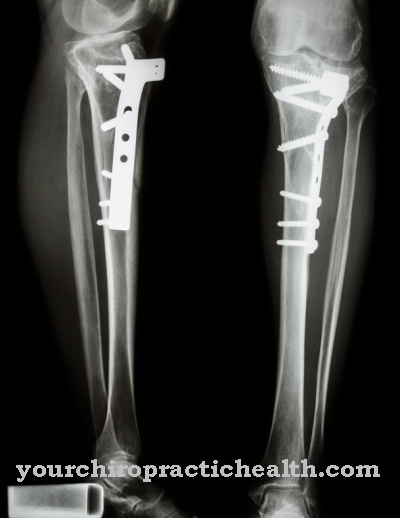Various Tuning fork tests serve to identify functional impairments of peripheral nerves and to identify and differentiate hearing problems according to sound conduction and sound sensation disorders. In medical practices, a specialized tuning fork is usually used, which vibrates at 128 Hertz for hearing tests and at half the frequency, at 64 Hertz, for nerve vibration tests with small weights attached.
What is the tuning fork test?

Tuning fork tests are used at certain points on the body to test the functionality of peripheral nerves and to determine impairments in hearing. Various tuning fork tests allow a distinction to be made between sound conduction and sound sensation disorders. Sound conduction problems affect the mechanical part of the hearing organ, i.e. the outer ear (auricle and external auditory canal) with the eardrum and the middle ear with the mechanical-acoustic transmission of sound waves to the cochlea.
In the cochlea in the inner ear, the incoming sound waves are converted by the hair cells into electrical nerve signals, which are passed on from the auditory nerve (vestibulocochlear nerve) to the central nervous system (CNS). A reduction in hearing, which is based on problems with the conversion, transmission or processing of the sound stimuli, i.e. on the electrical-nervous part of the hearing organ, is a sound sensation disturbance. Three different, easy-to-perform tuning fork hearing tests are available to distinguish sound conduction from sound sensation disorders. The hearing tests are carried out with the so-called Rydel and Seiffer tuning fork at 128 Hz.
In neurological tuning fork tests to check the functionality of peripheral nerves, one makes use of the fact that a certain type of rapidly adapting mechanoreceptors in the skin that respond particularly to vibrations, the Vater-Pacini corpuscles, very sensitively reflect nerve conduction problems. Like the hearing tests, the neurological vibration tests are carried out with the Reidel-und-Seiffer tuning fork, but with a vibration of 64 Hz, which is halved compared to the hearing tests Strength the vibrations are perceived.
Function, effect & goals
Vibration tests with the Rydel and Seiffer tuning fork are used for the early detection of any neuropathies that may be present due to previous illnesses such as diabetes or the autoimmune disease multiple sclerosis (MS). Functional damage to the nerves caused by chemotherapy, medication or chronic alcohol abuse can also be tested.Lesions of certain nerves due to entrapment (carpal tunnel syndrome), herniated disc and the like or due to an injury are also areas of application for the vibration tests.
The vibration tests can also be used to draw conclusions about functional failures in certain regions of the brain, for example after a stroke or a traumatic brain injury. The Rydel and Seiffer tuning fork with a vibration rate of 64 Hz is used for the tuning fork or vibration tests, which are easy to perform. The rate of oscillation lies in the reaction spectrum of the Vater Pacini cells, which are often found in the skin, particularly sensitive sensory cells that belong to the class of rapidly adapting mechanoreceptors.
Typical points for checking the vibration sensation are the outer and inner ankles of the foot, on the shin below the kneecap at the attachment point of the thigh muscles, on the iliac crest and on the sternum. The specialized tuning fork enables the determination of a (subjective) threshold value for the vibration perception on a scale from 0 to 8, with 8 representing the lowest strength. Vibration tests that reveal pathological values in certain areas of the body must be further clarified with other diagnostic methods for verification and more differentiated information. There are three different methods available for the hearing tests, which are relatively easy to perform, the Weber, Rinne and Gellé tests.
In the Weber experiment, the tuning fork is struck and the foot is held firmly in the middle of the skull (crown). The sound is transmitted to the skull bone and is perceived equally in both ears by a person with normal hearing. If the sound is heard louder in one ear, this indicates a one-sided sound conduction disorder in the ear, with which the bone sound is better perceived, or there is a sound sensation problem in the other ear. The subsequent Rinne experiment then provides clarity as to what type of hearing loss actually exists.
The vibrating tuning fork is held on the bone process behind the auricle. When the patient no longer perceives the weaker sound, the still gently vibrating tuning fork is held in front of the auricle. If the patient hears the sound again via the air conduction through the external auditory canal, but at the same time suffers from reduced hearing, the finding indicates a sensorineural disorder. If otosclerosis, a calcification of the ossicles in the middle ear, is suspected in the patient, the suspicion can be confirmed or refuted by the Gellé experiment.
As in the Rinne experiment, the tuning fork is held on the bone process behind the auricle and at the same time the external auditory canal is closed and a slight excess pressure is built up, which stiffens the ossicular chain a little and temporarily reduces hearing. If the sound of the tuning fork sounds quieter after the pressure build-up, the sound conduction in the area of the ossicular chain is OK. If the volume does not change, this can be interpreted as confirmation of the suspicion of otosclerosis.
You can find your medication here
➔ Medicines for earache and inflammationRisks, side effects & dangers
All neurological or hearing tests performed with the Rydel and Seiffer tuning fork are non-invasive and unrelated to the administration of any medication or other chemicals. The tests and trials therefore do not involve any dangers, risks or side effects and are also easy to carry out.
The risk of misinterpretation of the results is also extremely low. If in doubt, other diagnostic methods can be used to clarify the results. When investigating neural problems, measurements on the same points on the body should be repeated multiple times to ensure that there are no slips in one direction or the other.









.jpg)



.jpg)



.jpg)







.jpg)


